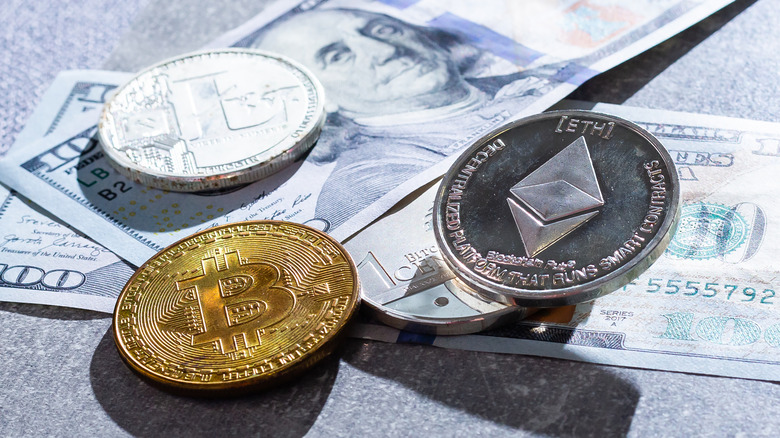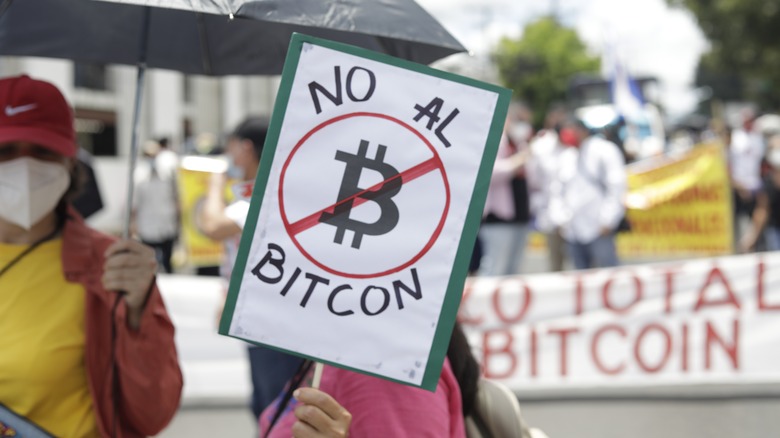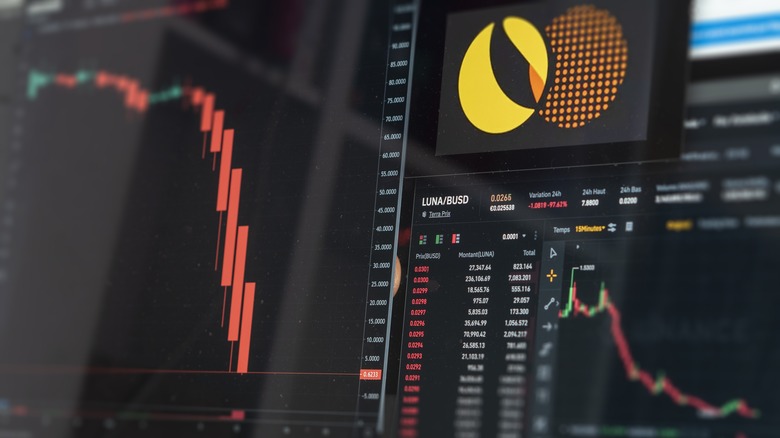The Sad Evolution Of Cryptocurrency
The cryptocurrency market is currently experiencing what many are calling a "crypto winter," with prices for leading tokens plummeting from 2021's all-time highs, and consumer confidence crashing alongside them. It wasn't too long ago that it seemed like the magic crypto money pot would never run out, with traders claiming life-changing profits after just a year or two in the market, and celebrities and influencers shilling any project that would pay them a high enough fee. Those 'wild west' days are well and truly over, leaving behind a litany of lawsuits, collapsed projects, and empty-handed investors.
So what went wrong? It shouldn't be a surprise to anyone that an unregulated market with billions of dollars flowing into it is an excellent target for scammers, and as the crypto space got bigger, so did the scams. Investors have also been burned by the collapse of several high-profile crypto firms in recent months, and those that managed to keep hold of their funds are staring down the barrel of huge losses as their tokens struggle to regain their value after recent crashes. There's even talk of a crypto 'ice age,' with some analysts claiming it will take years for coins to reach their peak valuations again if they ever do (via Financial Times). It's certainly not looking good for retail investors who bought into cryptocurrency at its peak, and now the big question is if the market can evolve into something more sustainable than its current state of chaos.
The origins of cryptocurrency
The idea for a digital currency is not a new one, as Forbes reports the idea first surfaced in the late Nineties. However, it took until 2009 for the pseudonymous Satoshi Nakamoto to launch the first functional cryptocurrency, Bitcoin (BTC). A year later, 10,000 BTC were traded for two pizzas, ascribing value to the digital token for the first time (via Forbes). The price of BTC rose in the following years, reaching $1,000 for a short period in 2013, only to crash back to $300 shortly after. It's fair to say that extreme volatility is nothing new for long-term "hodlers" (or "holders" in common parlance) in the crypto space.
It was in these early years that the emerging bitcoin ecosystem suffered its first major exchange collapse, with the popular Mt. Gox exchange halting withdrawals and then seemingly disappearing in 2014. Around 850,000 Bitcoins disappeared with it, and the perpetrators of the heist have never been identified. At the time, Forbes reported the coins were worth $450 million dollars, but they would be worth over $13 billion at today's exchange rates.
The strange case of QuadrigaCX
The next major case of a disappearing crypto exchange came in 2018, when Gerald Cotten, the CEO of Canada-based QuadrigaCX, seemingly died while on a trip to India. Cotten ran the exchange as a one-man show, controlling all the company's accounts and customer deposits. In the weeks leading up to his trip to India, some Quadriga users had complained that they couldn't access their funds and were waiting weeks or even months to get their money. After his death, it was expected that a "dead man's switch" would activate to unveil the private keys to unlock these accounts, but this never happened (via Coindesk). It appeared that around $190 million of customer funds were simply locked in cold storage with no way to access them. However, when journalists and investors started investigating what happened, a rather different picture emerged.
The cold wallets that were supposed to contain customer funds had in fact been mostly emptied, with a small fraction of the original deposits remaining. Cotten had set up fake accounts on the Quadriga platform and used those fake accounts to rack up huge trading losses, totaling around $115 million according to the Ontario Securities Commission. It seemed a very useful coincidence, then, that Cotten had seemingly died in a foreign hospital just as his fraud was about to be exposed. It's been claimed that the CEO faked his death as an exit scam, but investigations to establish what happened have proved inconclusive so far.
Proliferation of pump-and-dumps
There are also plenty of fraudsters in the crypto space who don't happen to run a major exchange, with one of the most common schemes to defraud investors being the 'pump-and-dump.' The problem has plagued cryptocurrency since its early days, and it's a fairly simple scheme in essence. Investopedia defines the term as "a manipulative scheme that attempts to boost the price of a stock or security through fake recommendations." In the cryptocurrency space, these recommendations took several forms, with one popular method being to pay celebrities to promote a coin. The temporary surge in interest causes the coin's price to spike, with the scammers selling their reserves of the coin to these new investors, leaving them holding the bag when the price collapses again.
This type of scheme is illegal, and several high-profile celebs have been fined for promoting them. Kim Kardashian is a notable example, as she was ordered to pay $1.26 million in fines after promoting EthereumMax, a token that lost over 97% of its value from its peak (via The Verge). As well as using celebrities or influencers to promote tokens, scammers also use groups on Discord or Telegram to organize their own pump-and-dumps, with an admin telling group members which coin to buy in order to try and cause a spike. News is then spread that the coin is spiking and group members use the outside interest from new investors to sell their coins off at a profit.
Crypto's use in organized crime
Part of the reason that pump-and-dump scammers and fraudulent CEOs feel that they're able to get away with their scams is the supposed level of privacy that the blockchain and cryptocurrency in general offers. It's this anonymity that also makes it appeal to bigger organized crime groups, including some of the world's biggest drug cartels. Reuters reports that groups in Mexico and Colombia are increasingly turning to cryptocurrencies to launder their income, with the space's lack of regulations making it an easier option than converting hard cash. Per Reuters, the gangs started by laundering small amounts of money through crypto exchanges, but in recent years, a Colombian cartel was caught processing millions of dollars via the blockchain.
A report by Europol also described how criminals are utilizing digital currencies to purchase illegal materials, with most child sexual abuse images now being paid for in crypto. Proceeds made from these sales are then laundered through unlicensed exchanges, with criminals passing currency through a string of wallets to make it almost impossible to track them. Anonymity has been touted as one of the key advantages of cryptocurrency since its earliest days, but with crypto's increasing popularity among criminals, it's getting harder for proponents to ignore the side effects that allowing users to be anonymous creates.
El Salvador's failed BTC experiment
Another key advantage that cryptocurrency enthusiasts are keen to promote is the use of bitcoin as an alternative to local currency. Since it's not regulated by a single entity, coins like BTC would offer users a global currency that remains valuable even if an individual country's economy crashes, or so the theory goes. The trouble is that since El Salvador implemented bitcoin as a legal currency in September 2021, the token has lost around 60% of its value, leaving adoption rates very low (via CNBC). Having a currency that is valued independently of a nation is all very well, but that currency needs to remain somewhat stable to be viable. Bitcoin, put simply, is not, or at least it hasn't been throughout the first year of El Salvador's experiment.
The Central American country is now facing the prospect of having to repay the loans it took to implement bitcoin infrastructure, while actual usage rates for the government-designed "chivo wallet" have tailed off after residents spent their $30 signup bonuses. It remains to be seen if the adoption of crypto will pay off for El Salvador in the long term, but for now, at least, it's hardly the stellar start that bitcoin's biggest evangelists envisioned.
Retail investors: once burned, twice shy
It wasn't just El Salvador's residents that stood to lose money as the crypto market crashed in early 2022. Many retail investors who entered the market amid the mainstream hype in 2021 have also been burned, with countless reports of amateur investors losing what amounted to their life savings after getting caught up in the mania. These investors, and those around them who have seen first-hand the fallout that these losses have caused, are not going to be keen to enter the cryptocurrency markets again, even if coin values do start to trend upwards.
Some analysts think it's unlikely that the highs seen through 2021 and early 2022 will ever be repeated, and that digital currency has already reached its peak, much like the Dotcom bubble did at the turn of the century. David Gerard, the author of Attack of the 50-Foot Blockchain, told The Guardian, "I'm sure crypto will bubble again. But if there's a genuine consumer bubble, it may not reach the heights of this one. The 2021-22 bubble made it to the Super Bowl. As many a dotcom found out 20 years ago, there's nowhere to go from there – you've reached every consumer in America."
Terra/Luna collapse
Just as a variety of other market conditions were combining to sink the price of digital currencies during the first half of 2022, the collapse of the Terra/Luna ecosystem sent further shockwaves through the crypto space. Terra was an algorithmic stablecoin that was designed to maintain a $1 peg and to do so, it relied on its companion token Luna for stability (via Coindesk). After a series of smaller depegging incidents at the start of May 2022, Luna abruptly crashed nearly 99% in value in just a couple of days between May 12th and 14th. This in turn caused Terra to significantly depeg, forcing founder and CEO Do Kwon to halt the blockchain as its security was deemed to be at risk.
Just a couple of days later, Kwon appeared to acknowledge that there was no way to rescue the tokens, as the Luna Foundation Guard's emergency reserves of BTC had already been sold off in an attempt to keep Luna stable. The total loss to investors from the ecosystem's collapse was estimated to be $42 billion, and criminal investigations were set up in Kwon's native South Korea to establish if the CEO's actions constituted criminal activity. Stablecoins were supposed to be one of the safest places to store value in the crypto space. But, the failure of Terra proved that even the biggest, and supposedly most secure, projects were vulnerable to near-instant collapse.
FTX and Sam Bankman-Fried
Further proving that seemingly no project is safe from collapse is the recent failure of FTX, the former second-largest cryptocurrency exchange. FTX and its CEO Sam Bankma-Fried's failure deeply impacted the crypto world. FTX has been responsible for bailing out several other ailing crypto firms in recent months, with Bankman-Fried telling CNBC in September it's "important that the industry gets through this [crypto winter] in one piece." However, after reports emerged that FTX's sister company Alameda Research was allegedly using the exchange's customer funds to trade with, Bankman-Fried himself became responsible for one of the industry's most damaging events of the year. The reports caused many investors to pull their money from FTX, triggering what amounted to a bank run, or as Binance chief executive Changpeng Zhao called it, a "significant liquidity crunch" (via Financial Times).
However, it would turn out that FTX's woes were more than just a short-term crunch, as further scrutiny revealed that the firm's balance sheets contained a multi-billion dollar hole. This forced Bankman-Fried and FTX to file for bankruptcy, with the former "king of crypto" resigning shortly after. To add to the chaos, FTX was hacked shortly after it collapsed, with the hackers able to steal around $477 million of customer funds.
Impeding regulations
With yet another high-profile exchange collapsing at breakneck speed, and both retail investors and businesses standing to lose billions of dollars, it seems inevitable that FTX's demise will bring about a fresh drive for government regulation of the cryptocurrency sector. Some industry players are in favor of more oversight: ironically, even Bankman-Fried backed calls for working closely with government agencies during an address to Congress in 2021. However, there are plenty of crypto proponents who view increased regulation as a hindrance, and something that would erase one of the key advantages of the technology.
It also brings into question just how useful cryptocurrency is to the wider market if these changes are made. If rules are brought in to make digital coins as heavily regulated as fiat currency, then are they really an attractive alternative to traditional money? Moreover, one of the big claims crypto evangelists have previously made is that digital coins can act as a hedge against inflation, but recent market performance has effectively disproved that theory (via CNBC). With digital coins seemingly being just as susceptible to overall market conditions as other forms of investment yet significantly riskier in nature, it's debatable how much value they offer to the average investor in their current state.
Is cryptocurrency dead?
Despite all of its current problems, the answer to whether cryptocurrency is dead is very much a resounding "no." While there's some debate over whether individual coin prices will ever reach the heights of 2021/22, the technology behind these ecosystems continues to develop, and traditional financial institutions are now beginning to implement crypto trading mechanisms into their own services (via Mondaq). The first trials of a digital dollar have also recently gotten underway, with nine major institutions working with the Federal Reserve Bank of New York to determine the feasibility of a ledger-based alternative to traditional dollars.
While cryptocurrency in its current form has proven too unstable to be an alternative to fiat money, that instability has also been the main driving force behind its adoption as an emerging asset class. The rapid evolution of the space has seen big players rise and fall in a matter of months, but much like the dotcom bubble, when the hype dies down, it's likely that a new group of dominant companies will emerge. From there, it remains to be seen how cryptocurrency and blockchain technology in general will continue to evolve.










